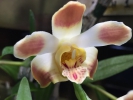|
|
|
|
|
| |
Flasks of
Chysis laevis 'Hopbrook' × self |
|
| |
|
|
| |
|
|
Click to Enlarge

Pod Parent Flowers |
Click to Enlarge

Pod Parent Blooming Plant |
Click to Enlarge

Offspring 'MC7434' Flower |
| Offspring photos are siblings of the plants you would receive. |
|
|
|
| |
Culture Notes from Donor: Parent plant: Temperature range I (60-83°F). Best grown pendulously on a basket, or better, a natural wood branch, with plenty of room. You can always add additional medium, as plant eventually can grow pseudobulbs to 12" or more. Resents root disturbance. Give copious water and food while in active growth to maximize pseudobulb size. Avoid wetting these long lasting flowers.
Comments: Parent plant: Large plant. Flowers open widely, with killer colors!
For additional origin/habitat information supplied courtesy of
Charles and Margaret Baker, see further below, near the bottom of this page.
|
Temperatures we attempt to use in the lab & greenhouse:
| For Species: |
|
Spring, Summer, Autumn: days average 77°F, nights 65°F; best fit is Intermediate 83-60°F
(Source:
Baker's Web OSC) |
| For Species: |
|
Winter: days average 68°F, nights 57°F; best fit is Cool 70-52°F
(Source:
Baker's Web OSC) |
|
About the name...
| Etymology of |
Chysis |
|
From Greek "chysis" melting. Refers to the fusing of the pollinia prior to the opening of the flowers in autogamous forms.
(Source:
Pridgeon 1992) |
| Etymology of |
laevis |
|
From Latin "laevis" smooth, shining.
(Source:
Mayr & Schmucker 1998) |
| Pronunciation of |
Chysis |
|
KYE-sis
(Source:
Hawkes 1978) |
| Pronunciation of |
laevis |
|
LYE-vis
(Source:
Hawkes 1978) |
|
If you would like to direct someone to this web page, please copy and paste this URL into your email:
http://troymeyers.com/d?013702
| Flask Information |
| Availability: |
We have sold all of the flasks for this item. |
| You should: |
Consider getting individual plants or compots instead of a flask.
You can place a "Notify Flask Recipients" Request, and either we or a flask recipient may contact you when plants are available.
You may also place a "Notify Retries" Request, and if an identical pollination (the same parents) is done again, we'll let you know.
You may reserve a flask, but it's very unlikely you'll get one ...this could only happen if we found a flask that we didn't know we had. |
| Yield Estimate: |
530 plants (based on flask surveys done 09/19/2003 through 03/01/2004)
|
| Plantlet Sizes: |
From many flasks 1 - 80 mm plants (based on flask surveys done 05/23/2003 through 06/09/2004)
From one most recently surveyed flask 45 - 70 mm (06/09/2004)
|
|
You might also want to:
|
View the seed assay for this item.
View items of the same species.
View items of the same genus.
|
| Ordering Information |
| You are not currently logged in. |
|
You must be a registered user and be logged in to reserve a flask or place a notification request. Please log in:
|
|
|
|
|
|
| |
The origin/habitat information below is supplied courtesy of Charles and Margaret Baker
The following information is based on the name of the plant provided by the donor, and assumes that the name is correct. If the plant has been misidentified, then the following information may not be correct.
This text is copyrighted by the Bakers and may not be reproduced without permission.
ORIGIN/HABITAT: Mexico, Guatemala, El Salvador, Honduras, and Nicaragua.
In Mexico, plants are found in the States of Veracruz and Chiapas where
they grow in shady forests at 1000-3300 ft. (300-1000 m). Over most of
their range, these plants grow in wet mountain forests on slopes facing
the Gulf of Mexico and the Caribbean at elevations up to about 5900 ft.
(1800 m). Although usually epiphytic, plants are sometimes found growing
lithophytically.
More about this information and the Bakers...
|
|
|
| |
|
|
|